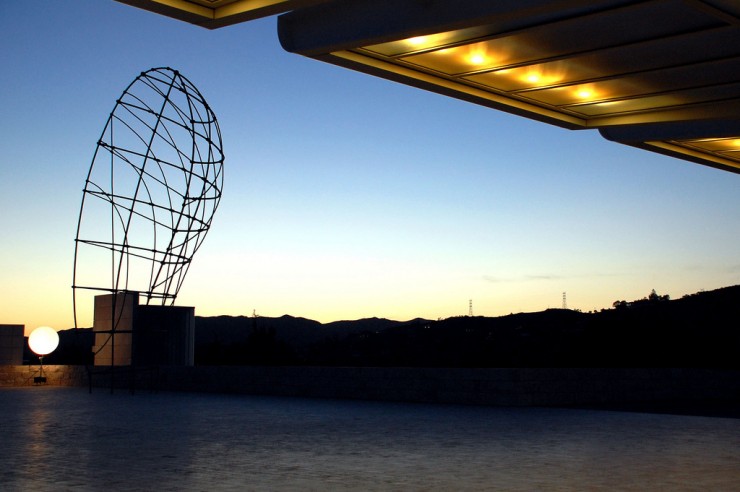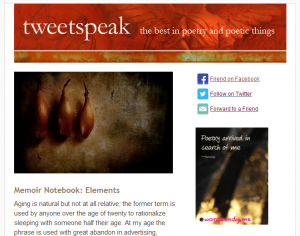We stand in line, waiting for the tram that will wend its way up the hill to its top where The Getty Center of Los Angeles stands. The J. Paul Getty Museum has two locations: The Getty Center in L.A. and The Getty Villa in Malibu. The Getty Center, situated in the Santa Monica mountains, features European paintings, drawings, sculptures, decorative arts and changing exhibitions in areas such as the Center for Photographs. The Getty Center houses so much art in multiple buildings, we won’t be able to see and savor everything it offers in one day.
As we wait, I see the tops of several large sculptures in a garden nearby. I’m tempted to visit, but I don’t want to be lost in reverie when the tram arrives. As the tram slowly climbs, I notice more sculptures set along a travertine wall on one side.
Once we disembark, the sweeping, ivory-colored modernist lines of The Getty Center loom further to my left. Architect Richard Meier used squares and circles to create a dramatic yet playful sense between the six buildings. The walls, windows, floors and exterior paving are organized in a grid of 30-inch squares. Travertine panels (from Bagni de Tivoli, Italy) cover the retaining walls, the bases of all the buildings, the paving stones for the arrival plaza, the Museum courtyard, and certain indoor walls between galleries. The high-end travertine is complemented by off-white enamel-clad aluminum panels used in other areas of The Getty Center.
Welcome to the Getty Center
We climb steps, pass Aristide Maillol’s larger-than-life female nude, “L’Air, “ and enter The Getty Center’s entrance hall, where I’m struck with how bright and open the lobby feels as sunlight streams in from towering glass walls and windows high above. A winding staircase leads to the next floor. Adults and children look like marbles bouncing off each other, creating a kind of kinetic energy and excitement. After perusing a map, I realize the size of the place compared with the time we have—we’ll have to focus on a few highlights, picking and choosing the galleries and tours, leaving out some of the most promising, such as the one about The Getty’s architecture.
A reproduction of the one painting I want to see before we leave hangs from a banner overhead. We pass through glass doors that open to a large open courtyard surrounded by four multi-level pavilions: North (Art before 1700), East (Art 1600-1800), South (Art 1600-1800) and West (Art after 1800). I spy a coffee cart and the Boulder Fountain in the courtyard. Several people carry large khaki umbrellas provided by The Getty to shield from the glare of the July sun, as they descend to The Central Garden with its labyrinth and water features.
Inside the Pavilions
In the Getty Center’s North Pavilion, we enter a darkened gallery of sacred art. I imagine being an illiterate woman of the Middle Ages as I study these religious images, like a mosaic with blue, yellow and red glass, created by artists attempting to convey a transcendent God through the use of stained glass and sculpture. I stand before a sculpture of Mary, but my mind is elsewhere.
We leave the dark space and step into the courtyard, struck by the sunlight. We transition to the Getty Center’s West Pavilion, which holds art after 1800, taking a moment along the path to admire the fountain and its giant boulders, approximately 180 million years old.
We ignore the terrace level of the West Pavilion, which houses the Center for Photographs, and the plaza level, which holds sculpture and decorative arts, drawing, and changing exhibitions. Instead, we head to the upper level to see European paintings after 1800.
In addition to indoor lighting, skylights in the galleries illuminate the paintings with natural light. I stop before a giant painting covering most of a wall titled Christ’s Entry into Brussels in 1889 by Ensor. Myriad faces and colors overwhelm; I try to find one corner to focus my gaze. In another gallery, I admire the lush blues of Cézanne’s Still Life with Apples. Other paintings lure me aside for a momentary gaze, such as Manet’s Spring, featuring a parasol-toting woman in a floral dress walking through a garden of blooms and green foliage. Soon, however, we are approaching the art I want to spend time with: Vincent van Gogh’s Irises.
A Closer Look at Van Gogh
When I was in college, my brother gave me a copy of the painting: an iconic image of a lone white iris amidst bright orange marigolds juxtaposed by large blue irises in varying stages of bloom. Having lived with it on my wall for years, I lingered at this original, standing as close as possible to gaze at the thickly applied paint—alive and full of texture compared with the flat poster I know so well.
The vivid shades of blues with touches of golden yellow and white near its center remind me of bluebeard irises I’ve seen at the Gamble Garden Center. Van Gogh painted the irises’ green leaves in various shades suggesting movement, as if they are upright ocean waves—the leaves seem to undulate in the wind. Even the ground with its rich and varying hues of brown and taupe appears alive.
In 1888, Van Gogh rented a house in Arles, France. Paul Gauguin came to be part of Van Gogh’s artist colony, but tensions mounted between the two men. In December, during an argument with Gauguin (according to one source), Van Gogh threatened him with a knife; but in a fit of depression or dementia, Van Gogh cut his own left ear lobe. Vincent van Gogh entered an asylum in Saint-Rémy, France, in May 1889. He began work on Irises within his first week, using the asylum’s garden for inspiration. I’m moved by this knowledge, hoping he found some solace in art and nature as he produced such beauty in the midst of great emotional and psychological pain.
We have to leave soon, but I take time to view Irises from different angles, sit on a nearby bench to contemplate, and then move in close again—so close, my nose almost touches it.
Just before we rush out to catch the tram, I try to write Vincent Van Gogh’s words about art from the audio tour, but my hand only captures this fragment:
“It is the artist’s duty to create a world more beautiful…than the one we live in.”
Photo by Peyri Herrera, Creative Commons, via Flickr. Post by Dolly Lee.
___________________________
Subscribe to our free weekly newsletter.
We’ll make your Saturdays happy with a regular delivery of the best in poetry and poetic things.
Need a little convincing? Enjoy a free sample.
- Regional Tour: The Getty Center in Los Angeles - November 6, 2015
- Regional Tour: A Glimpse of Yosemite - August 14, 2015
- Literary Tour: Mariposa Museum & History Center - May 20, 2015


Ann Kroeker says
Dolly, I love Van Gogh and went to see an exhibit at the Art Institute in Chicago two times when it was in town–it focused on the relationship between Van Gogh and Gauguin when they were in the yellow house in Arles. Your time with Irises, lingering nose-to-paint, reminds me of my time at that exhibit, moving in close and feeling so close to the artist even though we are separated by time and space. The art created that connection, that bridge.
Thank you for visiting the Getty Center. I doubt I’ll ever get there, so I love tagging along on your tour.
Dolly Lee says
Thanks, Ann, for coming along with me. I always appreciate a friend’s company 🙂